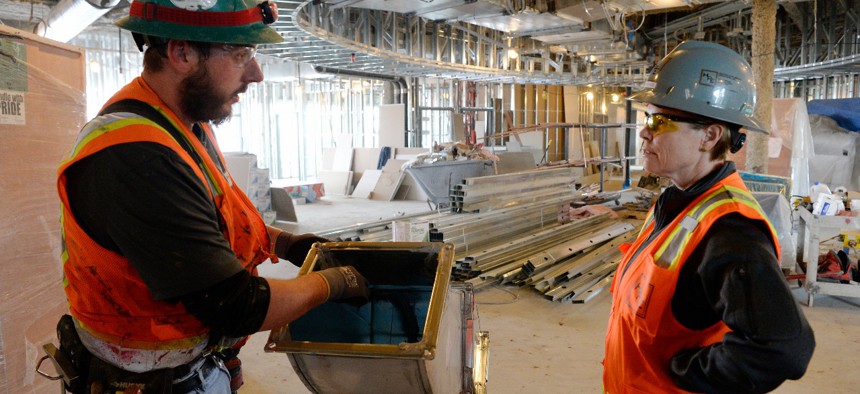Now is the Time for State and Local Investments in Apprenticeships

Instructor talks with first-year apprentice at construction site in Denver, Colo. Andy Cross via Getty Images
COMMENTARY | The Inflation Reduction Act includes tax credits for developers to promote the use of registered apprenticeships on clean energy projects. State and local governments should take action to make sure these incentives result in greater access to good jobs for workers and successful outcomes for communities.
State and local governments looking to deliver on the promise of clean energy infrastructure to their communities must not overlook one key component in doing so: registered apprenticeships.
Recent economic investments, including the Inflation Reduction Act, or IRA, will result in a clean energy construction boom and increased need for construction workers. Smartly, the IRA includes an apprenticeship incentive, a provision stipulating that building contractors can only receive the full amount of a production tax credit if they meet employment standards such as ensuring registered apprentices work a set percentage of hours on IRA projects. The IRA’s apprenticeship goals are a creative way to connect a diverse pipeline of trained workers with good jobs, while ensuring that clean energy goals are completed successfully and on time. By pairing these goals with support services and recruitment, enforcement capacity and policies that advance job quality and equity, state and local governments can make sure the employment opportunities stemming from the IRA work for all Americans.
Investments in apprenticeships will be key to ensuring that state and local governments can maximize the benefits of the IRA. Recruiting and retaining sufficient workers is an essential part of delivering on the promise of infrastructure and clean energy. The construction workforce is older than other industries, and the record numbers of job vacancies demonstrate that construction workers are particularly difficult to hire.
Expanding the number of apprentices entering the construction sector also requires changing the demographics of the industry to bring in more workers. Apprenticeship programs have generally become more racially, ethnically and gender diverse over time and are more diverse than the construction industry overall. But in many cases this change starts with a low baseline. For example, from 2016 to 2019, women apprentices in the trades increased by 57%, but were still only 3.6% of construction apprentices.
A variety of efforts are underway to meet infrastructure workforce goals nationally. For example, the Biden-Harris Administration hopes to catalyze workforce efforts through the Infrastructure Talent Pipeline, a national call to action to commit to workforce development in the broadband, construction and electrical sectors. The philanthropic community has stepped in to connect funders to infrastructure projects through the Catalyze Registry. Although apprenticeships have grown substantially over the past several years, additional steps are needed to ensure states and localities can deliver on the opportunity of clean energy jobs to constituents.
First, states and localities should stabilize funding for supportive services such as pre-apprenticeship and fund recruitment activities that increase access to and retention in construction and skilled trades. Pre-apprenticeship programs, also known as apprenticeship readiness programs, prepare workers for entry into registered apprenticeship programs and target underrepresented populations. For example, Building Pathways, a pre-apprenticeship program in Boston that serves 40% women and 90% workers of color, delivers a respectful workplace curriculum that targets harassment in the industry and partners with Care That Works, a child care pilot that supports child care during non-traditional hours, often necessary for construction work.
But not all apprentices can or should come through pre-apprenticeship programs. Government should also support intentional recruitment activities and collaborations with community organizations, tradeswomen’s groups, schools, the criminal justice system, the public workforce system and others. Funding for these services is spotty and inconsistent at the federal, state and local levels, and it is incumbent on governments to pair apprenticeship goals with support services and recruitment activities that attract, prepare and retain a diverse set of workers in good jobs.
Second, states and localities can play an intermediary role that forges connections and commitments between developers, organized labor and community organizations that work with local residents and jobseekers. To ensure the best results for apprenticeship availability from unions, builders must communicate their workforce needs months ahead of the project’s start date. Even further notice is required to ensure that residents of a particular jurisdiction are aware of and can access registered apprenticeship programs. State and local officials can help drive conversations with union and community partners at the table to build the apprenticeship pool needed to deliver on the IRA’s goals.
Finally, the IRA’s apprenticeship goals should be paired with adequate apprenticeship enforcement mechanisms that are necessary to make sure registered apprenticeship programs are of good quality. Twenty five states and territories’ apprenticeship programs are under the jurisdiction of the U.S. Department of Labor’s Office of Apprenticeship, while the remainder are the responsibility of a state apprenticeship agency. Adequate enforcement capacity on all levels is critical to ensure that apprenticeship programs are of good quality and enforcing Equal Employment Opportunity regulations – particularly as the number of apprentices is to grow substantially.
When the IRA passed into law in August, details about the massive bill’s apprenticeship provision didn’t grab headlines. But for state and local governments looking to take advantage of this once-in-a-generation opportunity to build green infrastructure, steps to expand and diversify the pool of apprentices in their jurisdictions are essential.
Marina Zhavoronkova is a senior fellow for workforce development at the Center for American Progress. From 2016 to 2021 she was assistant secretary for programs and performance at the Massachusetts Executive Office of Labor and Workforce Development.
NEXT STORY: Not Super Creative? Try This Approach





